Smoke Detectors
The majority of smoke alarms that fail to sound in a fire either have dead batteries or are missing them entirely. Perform the basic maintenance shown here and replace any smoke detector more than 10 years old. When you install smoke detectors, follow these guidelines:
• Place smoke detectors at least 12 in. (30 cm) away from corners and on surfaces that have fairly stable temperatures, like high on an inside wall or against the center of an insulated ceiling.
• Don't place smoke alarms in kitchens, bathrooms, furnace rooms or workshops where fumes, dust and smoke can trigger false alarms and contaminate the alarm's detectors.
• To prevent air movement from delaying the alarm, position alarms away from windows and at least 3 ft. (1 m) away from furnace ducts.
• Position alarms within 15 ft. (5 m) of bedrooms (some codes require one in each bedroom) so they can be heard through closed doors.
• Don't place alarms on tall walls, over stairways or other areas where it's inconvenient or dangerous to test them.
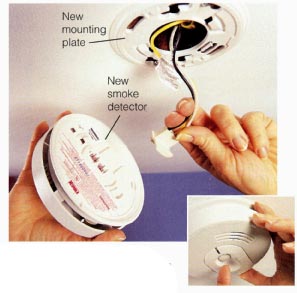
Above: Replace old AC-powered detectors. Turn off power at main
circuit panel, disconnect old detector, then install new mounting plate and detector. Replace interconnected alarms at the same time with compatible
units from the same manufacturer. Turn on power and test. Tip: Jot
the installation date on the mounting plate so you'll know when to
replace the detector.
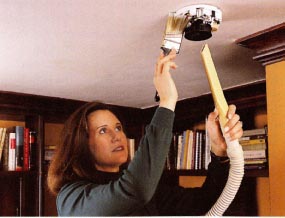
Above: Clean detectors and test batteries. Vacuum the interior of
detectors once a year, test detectors monthly with test button and install new batteries every six months.
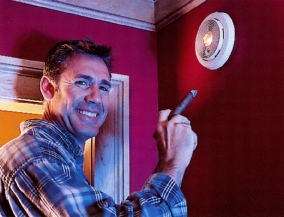
Above: Smoke test. Test your smoke alarms once a year by blowing
out a match and letting the smoke roll over the alarm—or use that cigar
you've been saving. Incense works, too.
CO Alarms
Carbon monoxide (CO) is an invisible, odorless gas produced by fireplaces, furnaces, stoves, water heaters and other appliances and heaters. When blocked chimney flues, poor natural drafting and leaks allow CO to spill into your home, it can be absorbed in the blood stream and result in serious illness or death. Accidental CO poisoning accounts for several hundred deaths in the United States and Canada every year. Most could be pre vented with a warning from an inexpensive CO alarm.
Install a CO alarm near the sleeping rooms on each level of your home on ceilings or walls away from drafts and solvents. Read directions for specific details.
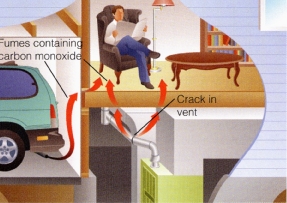
Above: Sources. Carbon monoxide is produced by gas-, oil- and wood-burning
devices. Auto exhaust and poorly vented furnaces are the most common
dangerous sources in a home.
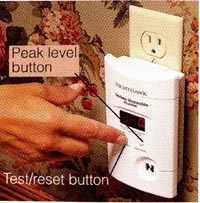
Above: Alarms. Test CO alarms monthly. Those with a digital display
will also show the peak CO level in your home when you push the peak
level button